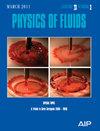数据驱动的雷诺平均湍流模型中的非唯一机器学习映射
IF 4.1
2区 工程技术
Q1 MECHANICS
引用次数: 0
摘要
最近,人们对使用机器学习进行湍流建模的兴趣日益浓厚,因此在文献中提出了许多数据驱动的湍流模型。然而,这些模型大多没有考虑克服非唯一映射(NUM)问题,而非唯一映射是训练和预测误差的重要来源。尽管大多数数据驱动模型都是在二维水流数据上进行训练的,但文献中只对一维水道水流数据引起的非唯一映射进行了深入研究。本研究旨在首次详细调查二维流动造成的 NUM。本文提出了一种量化 NUM 的方法,并在周期性山丘上的流动和冲击射流的数据上进行了演示。前者是壁界分离流,后者是包含停滞和再循环的剪切流。这项工作证实,二维流的数据会导致数据驱动湍流模型中的 NUM,而这些数据是常用的不变输入。这一发现在包含不同流动现象的两种情况下都得到了验证,从而表明 NUM 并不局限于特定的流动物理。此外,所提出的方法还显示,在两种情况下,包含低应变和旋转或接近纯剪切的区域会导致大部分 NUM--在周期性山丘上的流动和冲击射流中分别约为 76% 和 89%。这些结果促使粘度比被选为补充输入变量(SIV),证明了 SIV 可以减少二维流动数据引起的 NUM,从而提高用于湍流建模的张量基础机器学习模型的准确性。本文章由计算机程序翻译,如有差异,请以英文原文为准。
Non-unique machine learning mapping in data-driven Reynolds-averaged turbulence models
Recent growing interest in using machine learning for turbulence modeling has led to many proposed data-driven turbulence models in the literature. However, most of these models have not been developed with overcoming non-unique mapping (NUM) in mind, which is a significant source of training and prediction error. Only NUM caused by one-dimensional channel flow data has been well studied in the literature, despite most data-driven models having been trained on two-dimensional flow data. The present work aims to be the first detailed investigation on NUM caused by two-dimensional flows. A method for quantifying NUM is proposed and demonstrated on data from a flow over periodic hills and an impinging jet. The former is a wall-bounded separated flow, and the latter is a shear flow containing stagnation and recirculation. This work confirms that data from two-dimensional flows can cause NUM in data-driven turbulence models with the commonly used invariant inputs. This finding was verified with both cases, which contain different flow phenomena, hence showing that NUM is not limited to specific flow physics. Furthermore, the proposed method revealed that regions containing low strain and rotation or near pure shear cause the majority of NUM in both cases—approximately 76% and 89% in the flow over periodic hills and impinging jet, respectively. These results led to viscosity ratio being selected as a supplementary input variable (SIV), demonstrating that SIVs can reduce NUM caused by data from two-dimensional flows and subsequently improve the accuracy of tensor-basis machine learning models for turbulence modeling.
求助全文
通过发布文献求助,成功后即可免费获取论文全文。
去求助
来源期刊

Physics of Fluids
物理-力学
CiteScore
6.50
自引率
41.30%
发文量
2063
审稿时长
2.6 months
期刊介绍:
Physics of Fluids (PoF) is a preeminent journal devoted to publishing original theoretical, computational, and experimental contributions to the understanding of the dynamics of gases, liquids, and complex or multiphase fluids. Topics published in PoF are diverse and reflect the most important subjects in fluid dynamics, including, but not limited to:
-Acoustics
-Aerospace and aeronautical flow
-Astrophysical flow
-Biofluid mechanics
-Cavitation and cavitating flows
-Combustion flows
-Complex fluids
-Compressible flow
-Computational fluid dynamics
-Contact lines
-Continuum mechanics
-Convection
-Cryogenic flow
-Droplets
-Electrical and magnetic effects in fluid flow
-Foam, bubble, and film mechanics
-Flow control
-Flow instability and transition
-Flow orientation and anisotropy
-Flows with other transport phenomena
-Flows with complex boundary conditions
-Flow visualization
-Fluid mechanics
-Fluid physical properties
-Fluid–structure interactions
-Free surface flows
-Geophysical flow
-Interfacial flow
-Knudsen flow
-Laminar flow
-Liquid crystals
-Mathematics of fluids
-Micro- and nanofluid mechanics
-Mixing
-Molecular theory
-Nanofluidics
-Particulate, multiphase, and granular flow
-Processing flows
-Relativistic fluid mechanics
-Rotating flows
-Shock wave phenomena
-Soft matter
-Stratified flows
-Supercritical fluids
-Superfluidity
-Thermodynamics of flow systems
-Transonic flow
-Turbulent flow
-Viscous and non-Newtonian flow
-Viscoelasticity
-Vortex dynamics
-Waves
 求助内容:
求助内容: 应助结果提醒方式:
应助结果提醒方式:


